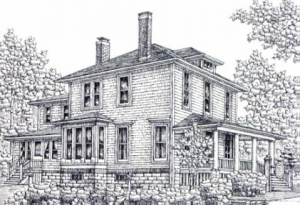Between 1845 and 1860, area that would become La Grange Park was settled by five industrious farmers. Henry Dieke, Henry Myer, Bill Robb, Louis Wesemann and A. H. Kemman all tilled their land, built homes and raised families on property that covers territory included in the present day village.
The Chicago fire of 1871 brought families seeking shelter to communities along the Burlington. Dozens of these families were taken in by early settlers, and were so pleased with the hospitality and surroundings they decided to stay. The farmers sold pieces of their acreage to the newcomers.
Much of the credit for forming La Grange Park is given to Alphonse H. Kemman, a son of one of the area’s early settlers; but he had a great deal of assistance from a fellow named Pete Swanson. The story goes that Swanson, an ambitious and hard working man, decided to supplement his income by selling alcohol in his home. In those days, an establishment of this sort was known as a “blind pig,” a forerunner of the speakeasy. It didn’t take long for word to get out, and soon the noise and antics of his clientele become more than most law abiding citizens could bear.
Since there was no local government in place and the Proviso Township Police force was spread too thin, a decision was made to incorporate. Kemman organized this effort and on July 14, 1892, the village, home to about 300 residents, was incorporated. Thus, La Grange Park was born with these boundaries: 31st Street on the north, Kemman Avenue on the east, Gilbert Avenue on the west, and Brewster and Ogden Avenues on the south. Not surprisingly, one of the first actions of the newly elected officials was to prohibit liquor sales.
For the first 50 years of its existence, La Grange Park was a quiet residential village. It had only a handful of businesses, no parks, and one school. Even as late as the 1930’s most streets lacked identifying signage. It had yet to obtain round-the-clock police protection, and the public works force lacked both the manpower and tools to perform many operations. Borrowing equipment from neighboring villages was a common occurrence.
Things began changing around 1943 when recommendations were made to create a park district, to permit light manufacturing along the Indiana Harbor Belt Line right-of-way, to enlarge the police and fire departments, and to make provisions for a central shopping area. All practical recommendations which ultimately increased tax revenue and helped modernize the village.
Today, with its present population of 13,300 the Village of La Grange Park is thriving.
For more information about La Grange Park, contact the Society.
